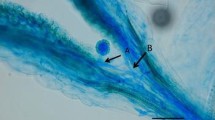Summary
The mentor effect has been investigated in poplars. Attempts to overcome interspecific incompatibility are analysed by pollen germination and pollen tube behaviour in situ, both for compatible and incompatible crosses. We have demonstrated that following the mixed pollination, the two pollen sets interact at different levels of the progamic phase. A hypothetical model is proposed which describes mentor effect as the result of interactions of antagonist and cynergic forces applying on compatible pollen and tubes. These forces promote pollen tube growth both on the female partner surface and within the tissues.
Similar content being viewed by others
References
Brewbaker JL, Emery GC (1962) Pollen radiobotany. Radiat Bot 1:101–154
Den Nijs APM, Oost EH (1980) Effect of mentor pollen on pistil-pollen incongruities among species of Cucumis. Euphytica 29:267–271
Dumas C, Knox RB (1983) Callose and determination of pistil viability and incompatibility. Theor Appl Genet 67:1–10
Dumas C, Knox RB, Gaude T (1984) Pollen-pistil recognition: new concepts from electron microscopy and cytochemistry. Int Rev Cytol 90:239–272
Gaget M (1988) Incompatibilité interspécifique chez Populus: effet Mentor. PhD Thesis, University of Lyon I
Gaget M, Said C, Dumas C, Knox RB (1984) Pollen-pistil interactions in interspecific crosses of Populus (sections Aigeiros and Leuce): pollen adhesion, hydration and callose responses. J Cell Sci 72:173–184
Gaude T, Dumas C (1987) Molecular and cellular events of self-incompatibility. Int Rev Cytol 107:333–366
Georges WL, Scott JW, Spillstoesser WE (1984) Parthenocarpy in tomato. Hortic Rev 65–84
Guries RP, Stettler RF (1976) Prefertilization barriers to hybridization in the poplars. Silvae Genet 25:37–43
Hamilton D (1976) Intersectional incompatibility in Populus. PhD Thesis, Australian National University, Canberra
Heslop-Harrison J, Heslop-Harrison Y, Shivanna KR (1984) The evaluation of pollen quality, and a further appraisal of the fluorochromatic (FCR) test procedure. Theor Appl Genet 67:367–375
Knox RB (1984) Pollen-pistil interactions. In: Linskens HF, Heslop-Harrison J (eds) Cellular interactions. Springer, Berlin Heidelberg New York, pp 508–608. (Encyclopedia Plant Physiology)
Knox RB, Willing RR, Ashford AE (1972a) Role of pollen wall proteins as recognition substances in interspecific incompatibility in poplars. Nature 237:381–383
Knox RB, Willing RR, Pryor LD (1972b) Interspecific hybridization in poplars using recognition pollen. Silvae Genet 21:65–69
Knox RB, Gaget M, Dumas C (1987) Mentor pollen techniques. Int Rev Cytol 107:315–332
Linskens HF (1986) Recognition during the progamic phase. In: Cresti M, Dallai R (eds) Biology of reproduction and cell motility in plants and animals. University of Siena, Italy, pp 21–31
Melchior GH, Seitz FW (1968) Interspezifische Kreuzungssterilität innerhalb der Pappelsektion Aigeiros. Silvae Genet 17:88–93
Mulcahy GB, Mulcahy DL (1986) Pollen pistil interaction. In: Mulcahy DL, Bergamini Mulcahy G, Ottaviano E (eds) Biotechnology and ecology of pollen. Springer, Berlin Heidelberg New York, pp 173–178. (Proc Int Conf Biotechnol Ecol Pollen, 1985, University of Massachusetts)
Pandey KK (1978) Proposed causal mechanisms of the “mentor pollen effect”. Incomp Newslett 10:87–93
Pandey KK (1983) Irradiated pollen — induced egg — transformation in plants: prospects for rapid plant improvement. In: Mulcahy DL, Ottaviano E (eds) Pollen biology and implications for plant breeding. Elsevier, Amsterdam, pp 117–127
Ramulu KS, Bredemeijer GMM, Dijkhuis P (1979) Mentor pollen effect on gametophytic incompatibility in Nicotiana, Oenothera and Lycopersicum. Theor Appl Genet 54:215–218
Sastri DC, Shivanna KK (1976) Attempts to overcome interspecific incompatibility in Sesamum by using recognition pollen. Ann Bot 40:891–893
Sokal RR, Rohlf FJ (1969) Biometry: The principles and practice of statistics in biological research. Freeman, San Francisco
Speranza A, Calzoni GL, Cresti M, Ciampolini F (1982) Effects of gamma irradiation on in vitro germination and ultrastructure of apple pollen. Env Exp Bot 22:339–347
Stettler RF (1968) Irradiated mentor pollen: its use in remote hybridization of black cottonwood. Nature 219:746–747
Stettler RF, Ager AA (1984) Mentor effects in pollen interactions. In: Linskens HF, Heslop-Harrison J (eds) Cellular interactions. Springer, Berlin Heidelberg New York, pp 609–623 (Encyclopedia Plant Physiology)
Stettler RF, Guries RP (1976) The mentor pollen phenomenon in black cottonwood. Can J Bot 54:820–830
Stettler RF, Koster R, Steenackers V (1980) Interspecific crossability studies in poplars. Theor Appl Genet 58:273–282
Taylor NL, Quarles RF, Anderson MK (1980) methods of overcoming interspecific barriers in Trifolium. Euphytica 29:441–450
Villar M (1987) Incompatibilité interspécifique chez Populus: approches physiologique et biochimique. PhD Thesis, University of Lyon I
Villar M, Gaget M, Said C, Knox RB, Dumas C (1987) Incompatibility in Populus: structural and cytochemical characteristics of the receptive stigmas of Populus alba and Populus nigra. J Cell Sci 87:483–490
Yoshida S (1984) Studies on freezing injury of plant cells. I: relations between thermotrophic properties of isolated plasma membrane vesicles and freezing injury. Plant Physiol 75:38–42
Author information
Authors and Affiliations
Additional information
Communicated by H. F. Linskens
Rights and permissions
About this article
Cite this article
Gaget, M., Villar, M. & Dumas, C. The mentor pollen phenomenon in poplars: a new concept. Theoret. Appl. Genetics 78, 129–135 (1989). https://doi.org/10.1007/BF00299765
Received:
Accepted:
Issue Date:
DOI: https://doi.org/10.1007/BF00299765




